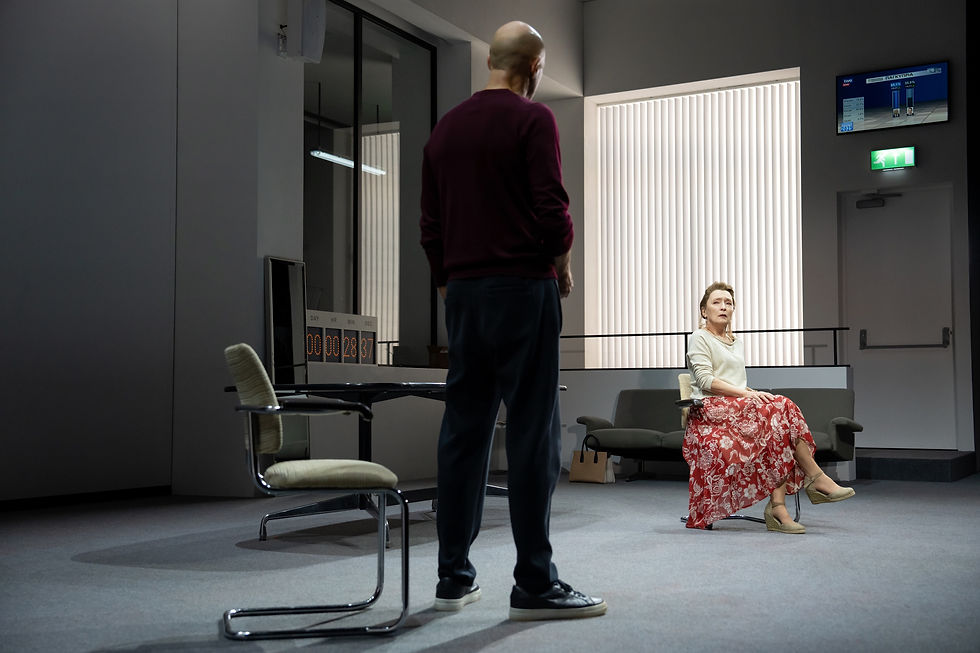Checking the Boxes
- Jonathan Kalb
- Oct 26
- 3 min read

I went to Caroline Guiela Nguyen’s Lacrima at BAM with great eagerness and curiosity. This was a major new work by the only woman with serious clout in the French theater (she is artistic director of the Théâtre National de Strasbourg). This much-acclaimed artist of Vietnamese, North African and French heritage wrote and directed Lacrima, a three-hour, intermissionless piece about the human costs of constructing an opulent wedding dress for a British princess. It’s been warmly received in several countries where it has toured, with reviewers admiring its global scope, deep research, stately design images, mix of zoom and live action, and mix of nonprofessional and trained actors. I found it, alas, tedious, irritating, dully written, and unfocused.
The stage is outfitted as a haute couture atelier in Paris, with sundry cutting tables, dummies, desks, and fabric rolls. Marion, its director, has a bustling, white-coated staff she is proud of, yet she will eventually find the pressure of making the dress so burdensome that she’ll attempt suicide. Had the play done full justice to Marion’s story it might have had a compelling center (the role is powerfully performed by Maud Le Grevellec). Instead Lacrima dissipates its energies in a half-dozen subplots, none of which is sufficiently fleshed out or artfully connected to the others.
With a giant screen used to show characters on Zoom calls, the show toggles between action in multiple locations. Frankly, I found the constant onscreen faces as depressing and physically enervating as I do in life, but the device does establish that work on the dress happens in far-flung locations, and people in them must communicate.
Near the beginning, we see the ridiculously vain and bombastic dress designer give Marion the commission, speaking in English so thickly accented we can barely understand him (the actor isn’t specified in the program and his lines aren’t translated in supertitles). Perhaps, since this man is obviously a self-absorbed celebrity bully, celebrity bullying will be the work’s main subject?
We then see various zoom conversations with lawyers and agents explaining the strict nondisclosure agreements and elaborate labor-oversight rules the dress commission will entail. Huge quantities of rare and expensive materials are involved, and the princess’ whim is evidently sacrosanct. Perhaps aristocratic secrecy and obscene displays of wealth will be the focus?

Attention then turns to different workers in Alençon, Normandy, and in Mumbai, India. Women in Alençon possess multigenerational expertise in lacemaking that is needed to restore an antique veil the princess wants to wear. In Mumbai, the handiwork of a skilled embroiderer named Abdul is needed to make a four-meter-long train incorporating more than 200,000 pearls under severe time pressure. Abdul is badly overworked and exploited and is going blind, so his boss is called out for breaching an international workplace ethics convention. The Alençon lacemakers, we learn, were also once regularly blinded by overwork but now have legal safety protections. So perhaps, then, the play will focus on the inequities of worker protection in globalized manufacturing and the need for unions?
There is more. Nguyen overpaints all these layers with two personal stories. One of the elderly Alençon lacemakers has long refused to investigate her sister’s mental illness and early death, but she’s forced to do so when her granddaughter falls similarly ill. And Marion is tormented by her abusive husband (in some painfully long scenes) and an emotionally disturbed daughter. Another focus still? Perhaps the play will be about mental illness and domestic abuse?
Nguyen has stressed in interviews that she feels driven to create theater about people who are overlooked and marginalized: “Theater has ignored so many people for so many years.” Thus the extreme diversity of Lacrima’s cast redresses a social ill. And the show’s dispersed (not to say scattered) center presumably redresses others. For me, this is wearisome. Tossing every cause and marginalized group Nguyen could think of into her show makes it resemble a prolonged exercise in virtue-signaling.
Checked boxes are not all that matters in powerful theater, even theater made for left-leaning audiences. To truly grip and move us—particularly in a piece built around constructing a garment—you have to settle on a body-shape and sew your pieces together in a way that makes it live.
Written and directed by Caroline Guiela Nguyen
BAM Harvey Theatre




Comments